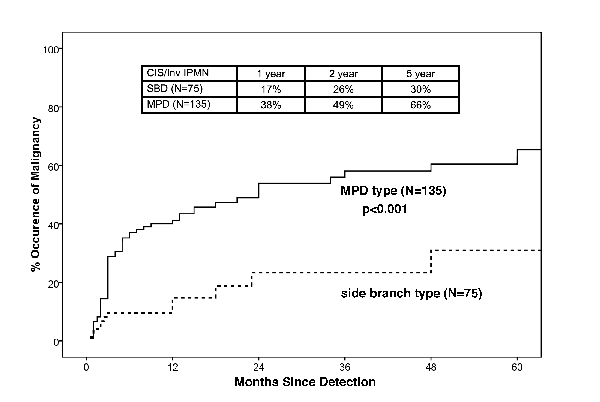Time Course for Malignant Degeneration of Pancreatic Intraductal Papillary Mucinous Neoplasms (Ipmn) Based On 210 Resected Cases
Toshiyuki Moriya*, L. William Traverso
General Surgery, Virginia Mason Clinic, Seattle, WA
Introduction: Using 93 cases of IPMN, a 2006 study by Levy, et al. (Clin Gastroenterol Hepatol 2006;4:460-8) showed a faster rate of malignant transformation from the date of detection when the IPMN was in the main pancreatic duct (MPD) versus just a side-branch duct (SBD). Since only 62 cases (66%) were resected they questioned the true histological diagnosis in the remainder. To confirm this helpful information we sought a larger cohort of cases where the diagnosis was reliable, i.e., using only resected cases. Method: Between 1989 and 2009, 210 cases of IPMN were resected and could be accurately categorized into the degree of dysplasia and location (MPD ± SBD or just SBD). The date of detection was either the onset of the first IPMN symptom (88%), or if asymptomatic, the first IPMN imaging (12%). The date of diagnosis for malignancy, if it occurred, was the time of resection. “Malignant” was defined as carcinoma-in-situ (CIS) or invasive (Inv) IPMN. The actuarial rate of malignant occurrence from the date of first detection was assessed using the Kaplan-Meier method. Then the risk of developing malignancy between MPD and SBD was compared (log-rank test). Results: The majority of the 210 cases were symptomatic (MPD 94%, SBD 77%, p=0.06). The mean time between detection (symptom or imaging) and the pathologic diagnosis (operation) was 18.6 ± 36.0 mo [0.5-180 mo]. The actuarial malignant occurrence rate was faster for MPD vs SBD location (figure). Conclusions: Lesions in the MPD degenerate faster into malignancy from the time of detection and should be resected as 38% and 49% were malignant 1 and 2 years after detection, respectively. Our study, based on 210 histologically proven cases of resected IPMN, supports the Levy study but our 5 year occurrence rate for SBD (limited to resected lesions) was higher (30% vs 15% for Levy). SBD lesions should be followed with caution as almost 20% might be malignant just one year after detection.
Back to Program



